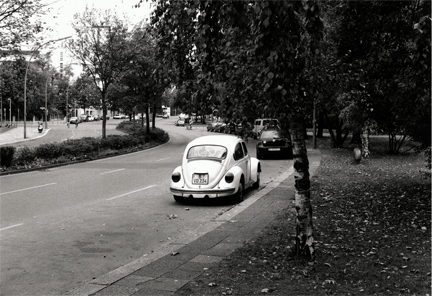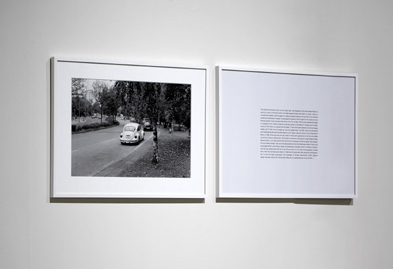| Peace and Anarchy |
| |

|
| |
| 2004 |
| Black and white fiber paper print and digital c-print |
| |
The symbol that became known as the "peace sign" was designed by the artist Gerald Holtom to serve as a logo for the Direct Action Committee Against Nuclear War (DAC) in London. Holtom, a conscientious objector, said he began by making a stylized drawing of himself with arms stretched outward and downward in despair. He associated this gesture with the figures of the rebels who face the firing squad in Goya's painting Executions of the Third of May, 1808. He also intended the design to correspond to the military semaphore-code flag signals for the letters "N" (nuclear) and "D" (disarmament). Both letters are signaled with two flags: "N" with arms down-stretched at forty-five degree angles, and "D" with one arm straight up, and one straight down. The DAC, which the philosopher and mathematician Bertrand Russell helped to found, began using the symbol on their letterhead in March of 1958. A few days later the sign made its initial public appearance at the first anti-nuclear march from London to Aldermaston, where Britain continues to manufacture nuclear weapons today. Bayard Rustin, a civil rights activist from the US and an advocate
of what he called "social dislocation and creative trouble," was one of the demonstrators at the first Aldermaston March. Rustin, who encouraged Martin Luther King to adopt civil disobedience strategies similar to Mahatma Gandhi's, took the new symbol back with him to the US and used it in non-violent anti-segregation protests there. After the first Aldermaston March in 1958 the DAC joined with other groups and individuals to form a new and larger organization—the Campaign for Nuclear Disarmament (CND). Holtom's design has been used by the CND as their official but un-copyrighted logo since that time. |
|
| |
 |
| |
| |
| |
| |
| |
| |
| |
| |
| |
| |
| |
| |
| |
| |
| |
| |
| |
| |
| |
| |
| |
| |
| |
| |
| |
| |
| |
| |
| |
| |
| |
| |
| |
| |
| |
| |
| |
| |
| |
| |
|
|
|